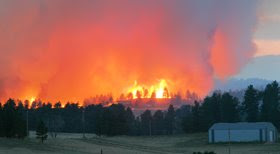"Ecosystems forged over time to thrive by being burned every 60 to 100 years are now being scorched every 10 to 15 years -- or even more often."
And a larger excerpt:
As scientists comb through Southern California's burnt landscape, they're finding new evidence that frequent fires are gradually replacing chaparral and sagebrush with highly flammable and prolific nonnative weeds.
Orange County's canyons offer a stark illustration. The 28,400 acres that burned over three weeks are in various stages of recovery. Upper elevations of the Santa Ana Mountains remain a moonscape.
But throughout the foothills, weeds are in full bloom amid blackened native sagebrush and grass.
Known as "type conversion," the landscape change is having a profound effect: extending the region's annual fire season, deepening the threat of mudslides and endangering animal species.
The culprit isn't the size of wildfires, but their frequency. Ecosystems forged over time to thrive by being burned every 60 to 100 years are now being scorched every 10 to 15 years -- or even more often.
Nonnative weeds have been encroaching on Southern California's wild lands for centuries, carried over in the hoofs of Spanish livestock, accidentally spread through contaminated crop seed, intentionally planted along streams to control erosion.
In recent years, scientists have argued that a fire frequency that would benefit a conifer forest through thinning would destroy a coastal ecology by helping to spread invasive species, such as mustard, star thistle and ripgut brome.
Rich Hawkins, a veteran fire chief for the Cleveland National Forest, learned the rule of thumb from an old forest ranger 30 years ago.
"If a site burns three times within 20 years," Hawkins said, "you'll see most of the chaparral lost on that site."
Because of imprecise historical habitat mapping, just how much of Southern California's wild lands have undergone type conversion because of fire is unknown.
"But clearly, a large part of the native landscape has already been lost," Keeley said.
Firefighters hate nonnative weeds as much as biologists do. Mustard, for instance, can quickly grow hip high with winter rains, then dry out just as fast, becoming a field of kindling.
It's one reason the region's fire season is getting longer and more destructive. "It makes it impossible to fight a wind-driven fire," Hawkins said. "That's why thousands of homes burned down in San Diego County."





